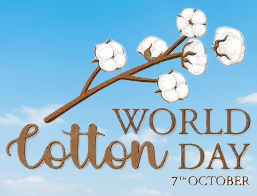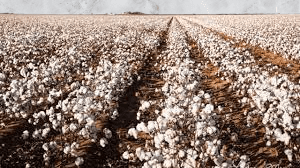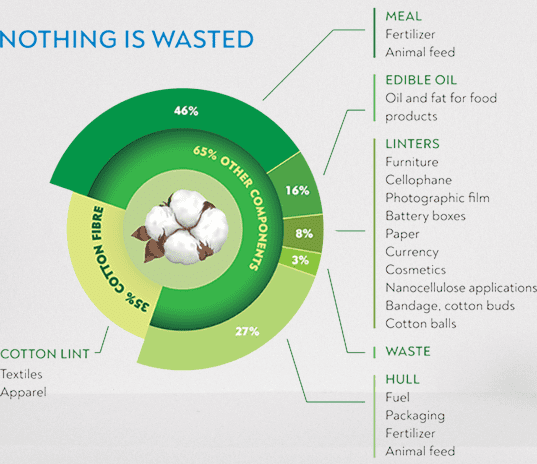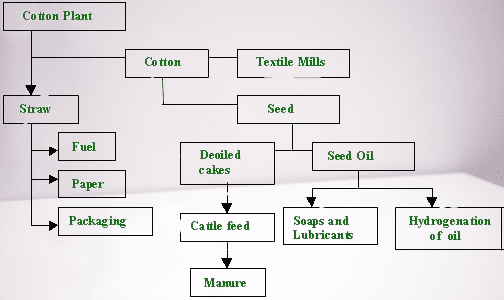World Cotton Day: World Cotton Day is a Celebration of cotton and an opportunity to show its enduring positive impact. The World Cotton day is celebrated on 7 October as a global celebration of cotton and its stakeholders, from field to fabric and beyond. In August 2021, the General Assembly of the United Nations recognized the unique benefits of cotton by proclaiming 7 October of each year as World Cotton Day.

World Cotton Day
The objective of World Cotton Day is to raise the visibility of the cotton sector and awareness of the critical role that it plays in economic development, international trade and poverty alleviation.
Cotton is the most important of the natural fibres, used daily in apparel and home furnishings. Cotton is a critical means of livelihood for millions of smallholders and their families by providing employment and income. It represents an important source of export revenues for some of the poorest countries in the world. Cotton is one of the most common fabrics in our wardrobes. It is comfortable, hypoallergenic, breathable and durable. But cotton represents so much more than just a commodity. This natural fabric is a life-changing product worldwide that sustains 32 million growers (almost half of them women) and benefits over 100 million families across 80 countries in 5 continents.

Cotton is a global commodity grown in over 75 countries across five continents and traded worldwide. World Cotton Day — held annually on 7 October — is an opportunity to highlight the role of cotton in creating jobs and maintaining economic stability in cotton-producing countries, particularly in least-developed countries (LDCs). Celebrations marking the day aim to foster sustainable trade policies and to enable developing countries to benefit from participating in every step of the cotton value chain.
The World Cotton Day offers a unique opportunity to renew the commitment to a sustainable cotton sector for better production, better nutrition, a better environment, and a better life, leaving no one behind. This year’s theme of World Cotton Day aims to raise visibility of the cotton sector and awareness of the critical role that it plays in economic development, international trade and poverty alleviation. The observance also aims to highlight the importance of sustained, inclusive and sustainable economic growth, full and productive employment and decent work for all.
A United Nations General Assembly decision on 30 August 2021 officially recognized 7 October as World Cotton Day following a proposal submitted by Benin, Burkina Faso, Chad, Cote d’Ivoire and Mali.
The UN resolution (A/RES/75/318) proclaiming World Cotton Day acknowledges the vital role cotton plays, recognizing the livelihoods and subsistence it provides for millions of people and its broader economic and social impact around the world.

The World Cotton Day aims to
- Give exposure and recognition to cotton and all its stakeholders in production, transformation and trade.
- Engage donors and beneficiaries and strengthen development assistance for cotton.
- Seek new collaborations with the private sector and investors for the cotton-related industries and production in developing countries.
- Promote technological advances, as well as further research and development on cotton.
Facts about cotton on World Cotton Day
- Compared to synthetic alternatives, cotton is renewable and bio-degradable and hence is the most sustainable raw material for the textile industry
- It’s the only agricultural commodity that provides both fiber and food.
- Contrary to popular belief, cotton is not a thirsty crop. It’s a xerophyte, so it thrives in dry, arid conditions where other crops can’t grow.
- It is estimated that about 32 million farmers produce cotton globally and nearly half of them are women.
- Around 80 percent of cotton is used in apparel, 15 percent in home furnishings and the remaining 5 percent mostly accounts for non-woven applications, such as filters and padding.
- Cotton occupies a mere 3% of the world’s agricultural area – yet it meets 27% of the world’s textile needs.
- Cotton is a tough, hardy, flexible plant that is indeterminate in nature and can be grown all year long even in harsh conditions.
- The majority of consumers say cotton is the best fabric for active wear, and more than 2 out of 3 say that 100% cotton sheets offer the best night’s sleep.
- Cotton is used to make a lot more than comfortable fabric! A ton of cottonseed produces about 320 pounds of oil – which can be used for cooking, cosmetics and soap, among other things – while cottonseed meal and cake can be used as animal feed and fertiliser.
- The top five cotton producing countries are China, India, the United States of America, Brazil and Pakistan, which together account for more than three-quarters of global production.
- Cotton faces a number of uncertainties on both the production and demand sides that need to be properly addressed if the sector is to realize its full potential in supporting economic growth and sustainable development.
- A single tonne of cotton provides year-round employment for 5 people on average, often in some of the most impoverished regions.
- Cotton-based filaments are appealing to 3D printers because they conduct heat well; become stronger when wet; and are more scalable than materials like wood.
- In addition to its fibre used in textiles and apparel, food products can be derived from cotton, such as edible oil and animal feed from the seed
- It’s a poverty-alleviating crop in some of the least developed countries in the world, providing sustainable and decent employment to people across the globe.
- It biodegrades quickly compared with synthetic alternatives, decreasing the amount of plastics entering our waterways and helping to keep our oceans clean.
- It’s the only agricultural commodity that provides both fiber and food.
- As a crop that grows in arid climates, it thrives in places no other crop can.
On World Cotton Day, Stakeholders from the global cotton community come together to speak on the many advantages of cotton–from its qualities as a natural fiber, to the many benefits people obtain from its production. Topics of this year’s World Cotton Day include sustainability, women in cotton, brand and retailer partnerships, and more.
World Cotton Day Celebrations
The WTO hosted the first World Cotton Day on 7 October 2019 in response to an initiative of the Cotton-4 countries: Benin, Burkina Faso, Chad and Mali. The event was organized by the WTO Secretariat in collaboration with the secretariats of the United Nations Food and Agriculture Organization (FAO), the United Nations Conference on Trade and Development (UNCTAD), the International Trade Centre (ITC) and the International Cotton Advisory Committee (ICAC).
The first World Cotton Day was attended by over 800 participants at WTO headquarters, including ministers, heads of international organizations, high-level officials, Geneva-based delegates and the global cotton community — national growers associations, traders, inspection service providers, cotton promoters, development assistance partners, scientists, scholars, retailers, brand representatives and the private sector. It served as a key opportunity for participants to share knowledge and showcase cotton-related activities and products.
Importance of Cotton
Cotton is the most important fibre crop produced in India because of the variety of its applications in all fields. Cotton is a Kharif crop that requires approximately 8 months to cultivate. Although in Tamil Nadu, cotton is grown both as a Kharif as well as a rabi crop. In Punjab and Haryana, it is sown in the months of April-May and harvested in the season of December- January. Cotton cultivation has been practiced in India for ages.
Even the Vedic scriptures of India talk about cotton cultivation, cotton spinning, and weaving. India used to dominate the global market due to its flourishing cotton industry but in the 18th century, it was taken over by the British who systematically destroyed the cotton industry in India to fuel the industrial revolution in Europe. Cotton has had a great impact on Indian history and was an iconic statement for the Freedom movement as it figured even on the famous spinning wheel or Charkha of Gandhi Ji.
Types and Uses of Cotton
There are basically four types of commercially grown cotton which are:-
- Gossypium hirsutum
- Gossypium barbadense
- Gossypium arboreum
- Gossypium herbaceum
Cotton also has various uses in the industrial and domestic sector such as:
- It is very widely used in the textile industry. The use of cotton fabric involves every type of clothing from jackets to normal shirts.
- It is also used in the medical field. It is known to be used after birth to remove the placenta.
- The Cotton plant is used in menstrual cycle pain and for irregular periods.
- Cotton is used in making sanitary pads and diapers.
- Levant cotton seeds are also used as food and for oil extraction.
- It is used for making bedsheets.
- It is used in the manufacture of coffee filters.

Uses of cotton fibres are because of its specific characteristics such as cotton fibres are soft, cool, breathable, very good absorbent etc. few uses of cotton fibres are listed below–
- It is widely used in the textile industry. Uses of cotton fabric involves every type of clothing from jackets to normal shirts.
- It is largely used in the medical field. It is known to be used after birth to remove placenta.
- Cotton plant is used in menstrual cycle pain and for irregular periods.
- Cotton is used in making sanitary pads and diapers.
- Levant cotton seeds are used as food and for oil extraction.
- It is used in making bed sheets.
- It is used in coffee filters.
- It is used in making highly absorbent cloths for cleaning purposes.
- Cotton plants are used to feed cattle.
- Cotton fibre is used in making cords and ropes.
- It is used in making cord for car tyres, plastic reinforcing.
- Cotton seed is used in plastics, explosives, high quality paper, cushions, flat panel television screens.
- It is used in computer chip boards as well.
- Cotton seed oil is used in margarine, salad dressing, in manufacturing of candles, soaps and detergents, artificial leather etc.
- Fibre from stalks is used for pressed paper and cardboard.
Today, the world uses more cotton than any other fiber, and cotton is a leading cash crop in the U.S. At the farm level alone, the production of each year’s crop involves the purchase of more than $5.3 billion worth of supplies and services. This stimulates business activities for factories and enterprises throughout the country. Processing and handling of cotton after it leaves the farm generates even more business activity. Annual business revenue stimulated by cotton in the U.S. economy exceeds $120 billion, making cotton America’s number one value-added crop.
Cotton is a part of our daily lives from the time we dry our faces on a soft cotton towel in the morning until we slide between fresh cotton sheets at night. It has hundreds of uses, from blue jeans to shoe strings. Clothing and household items are the largest uses, but industrial products account from many thousands of bales.
All parts of the cotton plant are useful. The most important is the fiber or lint, which is used in making cotton cloth. Linters – the short fuzz on the seed – provide cellulose for making plastics, explosives and other products. Linters also are incorporated into high quality paper products and processed into batting for padding mattresses, furniture and automobile cushions.
The cottonseed is crushed in order to separate its three products – oil, meal and hulls. Cottonseed oil is used primarily for shortening, cooking oil and salad dressing. The meal and hulls that remain are used either separately or in combination as livestock, poultry and fish feed and as fertilizer. The stalks and leaves of the cotton plant are plowed under to enrich the soil.
Some cottonseed also is used as high-protein concentrate in baked goods and other food products.
Cotton is one of the most important commercial crops cultivated in India and accounts for around
25% of the total global cotton production. It plays a major role in sustaining the livelihood of an
estimated 6 million cotton farmers and 40-50 million people engaged in related activity such as
cotton processing & trade. The Indian Textile Industry consumesa diverse range of fibres and
yarns and the ratio of use of cotton to non – cotton fibres in India is around 60:40 whereas it is
30:70 in the rest of the world.
Apart from being the provider of a basic necessity of life i.e. clothing which is next only to
food, cotton is also one of the largest contributor to India’s net foreign exchange by way of
exports in the form of raw cotton, intermediate products such as yarn and fabricsto ultimate
finished products in the form of garments, made ups and knitwear. Due to its economic
importance in India, it is also termed as “White-Gold”.
India got 1st place in the world in cotton acreage with 120.69 Lakh Hectares area under cotton
cultivation i.e. around 36% of world area of 333 Lakh Hectares. Around 67% of India’s cotton
is grown on rain-fed areas and 33% on irrigated area. In terms of productivity, India is on 38th
rank with yield of 510 kg/ha.
India is having 1st place in the world with estimated production of 362.18 lakh bales (6.16
Million Metric Tonnes during cotton season 2021-22 i.e., 23% of world cotton production of
1555 lakh bales (26.44 Million Metric Tonnes). India is also the 2nd largest consumer of cotton
in the world with estimated consumption of 338 lakh bales (5.75 Million Metric Tonnes i.e.
22% of world cotton consumption of 1507 lakh bales (25.63 Million Metric Tonnes)
For more interesting articles visit read4knowledge.